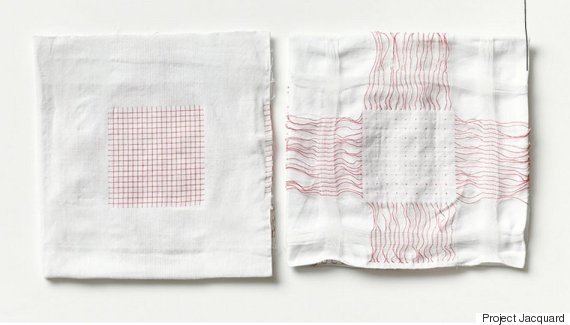Google and Levi have partnered to create a type of interactive cloth that might just be the best material the fashion industry has seen since it was first introduced to denim in the 19th century.
The giants of tech and fashion have joined hands to turn your regular not-so-smart jeans into wearable computers. That's right, your trousers could one day switch on the music on your phone at the stroke of a pocket -- a potential minefield for people who constantly have their hands in their pockets.
Project Jacquard's aim is to transform 'everyday objects such as clothes and furniture... into interactive surfaces.' Oh joy.
So how does a piece of cloth turn into a touch screen?
The answer is two-fold: conductive yarn and sensor grids.
Project Jacquard's yarn looks like the regular bobbins of thread used in home-sewing kits except that it's made from thin, metallic alloys as well as natural and synthetic materials including cotton, polyester and silk.
![project jacquard yarn]()
In order to convert our hand gestures into meaningful commands, researchers are using small sensors containing tiny circuits 'no larger than the button on a jacket,' to capture touch interactions.
![project jacquard sensor]()
This small grid sends information from your hand to your phone or any other device and voila -- your jeans have suddenly become wearable computers.
Ivan Poupyrev who is spearheading the project told Wired:
"It’s ridiculous that our clothes don’t already talk to our tech.
"Any time you put your phone into your pocket ...you have a smart jacket… the only problem is they don’t talk to each other. There’s no connection between them. So this work, we can actually kind of close the circuit.”
Jacquard claims the materials are cost effective to produce, a major hurdle that wearable tech is yet to jump over, and based on CNET's demo at Google I/O, the product will be relatively easy to use.
The only problem is that it might be a little too easy to use, especially if you're prone to wiping your hands on your clothes. Oh and you obviously don't want your lower end lighting up every time your hand accidentally brushes your leg.
Poupyrev acknowledged these challenges saying:
“If you’re serious about it, you know people don’t want to glow like a Christmas tree.
“This is not a technology problem...it’s really a design problem. Design, and cultural understanding.”
Jacquard's offering is the closet we've come to true wearable technology so far, but we may be quite a few embarrassing LED scenarios away from it becoming high street fashion.
The giants of tech and fashion have joined hands to turn your regular not-so-smart jeans into wearable computers. That's right, your trousers could one day switch on the music on your phone at the stroke of a pocket -- a potential minefield for people who constantly have their hands in their pockets.
Project Jacquard's aim is to transform 'everyday objects such as clothes and furniture... into interactive surfaces.' Oh joy.
So how does a piece of cloth turn into a touch screen?
The answer is two-fold: conductive yarn and sensor grids.
Project Jacquard's yarn looks like the regular bobbins of thread used in home-sewing kits except that it's made from thin, metallic alloys as well as natural and synthetic materials including cotton, polyester and silk.

In order to convert our hand gestures into meaningful commands, researchers are using small sensors containing tiny circuits 'no larger than the button on a jacket,' to capture touch interactions.

This small grid sends information from your hand to your phone or any other device and voila -- your jeans have suddenly become wearable computers.
Ivan Poupyrev who is spearheading the project told Wired:
"It’s ridiculous that our clothes don’t already talk to our tech.
"Any time you put your phone into your pocket ...you have a smart jacket… the only problem is they don’t talk to each other. There’s no connection between them. So this work, we can actually kind of close the circuit.”
Jacquard claims the materials are cost effective to produce, a major hurdle that wearable tech is yet to jump over, and based on CNET's demo at Google I/O, the product will be relatively easy to use.
The only problem is that it might be a little too easy to use, especially if you're prone to wiping your hands on your clothes. Oh and you obviously don't want your lower end lighting up every time your hand accidentally brushes your leg.
Poupyrev acknowledged these challenges saying:
“If you’re serious about it, you know people don’t want to glow like a Christmas tree.
“This is not a technology problem...it’s really a design problem. Design, and cultural understanding.”
Jacquard's offering is the closet we've come to true wearable technology so far, but we may be quite a few embarrassing LED scenarios away from it becoming high street fashion.